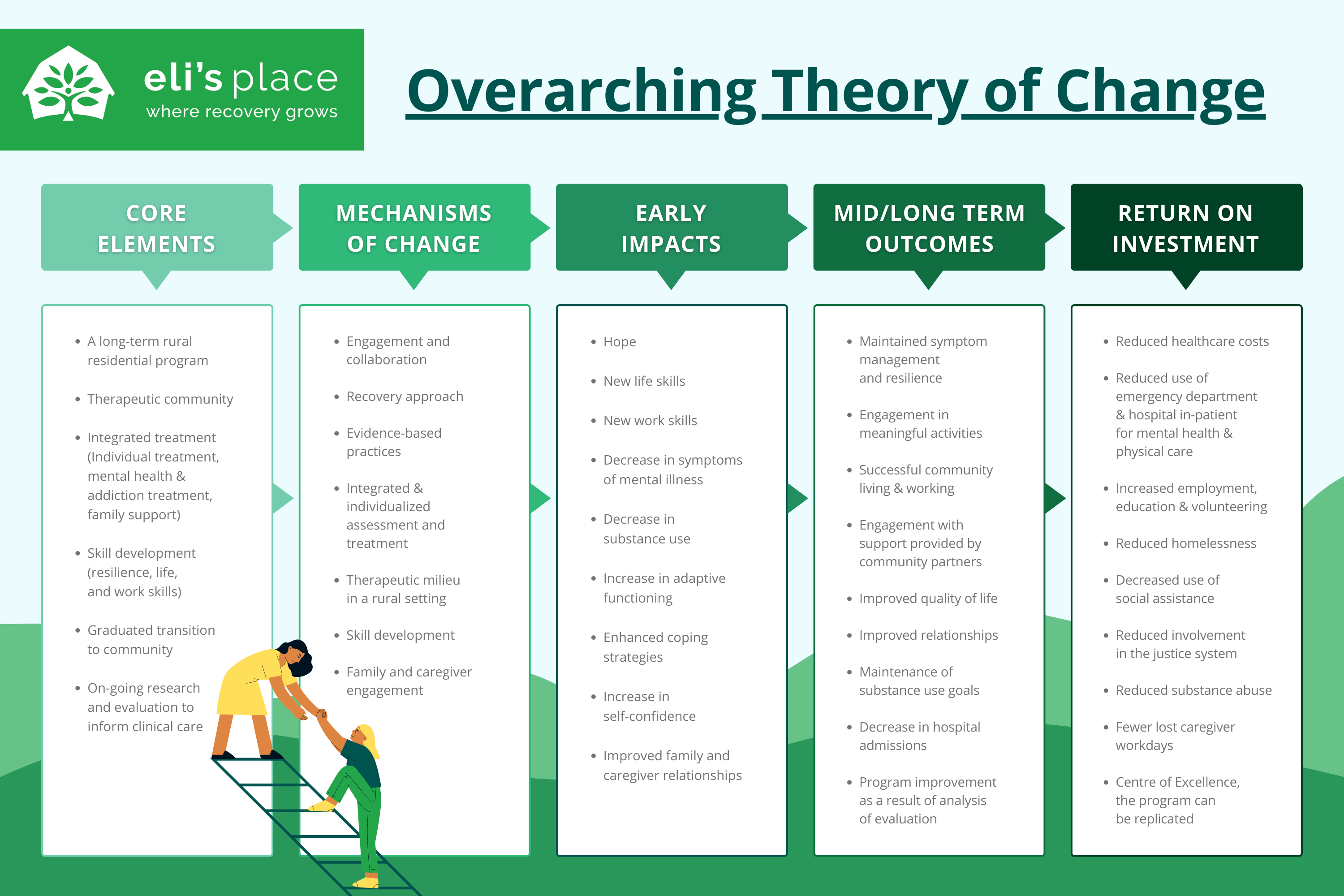But what is the pathway towards our stated goals? How will we know when the goals have been met for individuals and the Eli’s Place program? Understanding that the process may look different for each person is where a thoughtfully constructed theory of change (ToC) comes into play to ensure the success of our program model. With a ToC roadmap in place, we can support emerging adults to reach their destination — a place of independence, stability and resilience.

What is the Theory of Change (ToC)?
Change. It’s a challenging subject for some and a constant practice for others. It’s sometimes feared or held in contempt, dismissed as “change for change’s sake.” At the other end of this spectrum, change is embraced and understood as the only means for growth whether personal, societal or global. Wherever one is on this continuum, it’s generally accepted that growth is not possible without change.
ToC can best be understood as a methodology for evaluating change in a variety of contexts. It helps organizations clarify the steps needed to achieve their desired outcomes and how they will measure their progress along the way. These outcomes might be large in scope, involving social or educational programs, corporate strategies or government programs. ToC enables a mapping of an organization’s (or an individual’s) large-scale expectations, goals and changes over a period of time. According to the Centre for Theory of Change, articulating a ToC for an organization can assist with knowing what to evaluate and when to refine the process in response to outcomes.
In the 1970s, Carol Weiss used the ToC term to “explain both the mini-steps that lead to the long-term goal and the connections between program activities and outcomes that occur at each step of the way.” What is central to ToC is that change is not linear; instead, it is understood to be a process which may loop back on itself. A term we might be familiar with today to describe ToC is “iterative” in that one might repeat or review steps in the process while still proceeding towards the end goal.

The necessary scaffolding
Whatever the setting in which it’s employed, ToC has specific criteria by which to evaluate success. The key criteria are plausibility (does the plan make sense?), feasibility (is it doable?) and testability (can it be measured?). Indicators for evaluation are identified and recorded. Defining and measuring outcomes is an integral part of the ToC process.
The development of an organization’s ToC is by definition ongoing and participatory, involving many different stakeholders. An organization might also define overarching principles which guide a defined ToC. For example, a commitment to diversity, equity and inclusion might preface the stated ToC.
In the 1990s ToC began being widely used in the education sector and since the early 2000s it has become central to public health and other social service sectors. Studies have shown that organizations designing programs for complex issues such as mental illnesses with co-occurring conditions have seen positive outcomes using ToC as a guide. Many of Canada’s preeminent mental health organizations have created a ToC by which to involve and inform stakeholders. For example, the Canadian Mental Health Association has a high-level ToC which guides their work.

Integral to effective mental health treatment
In the mental health space, ToC has become an accepted framework for understanding and facilitating change. It can provide a structured and collaborative approach which includes the client, clinicians and others involved in care. In a milieu setting (an organized communal setting), the opportunity to impact success may be even greater than in a traditional clinical setting.
Because ToC is iterative, it can be responsive to the needs of a changing clientele. It can be adapted to reflect the diversity of individual experiences. ToC recognizes that change is dynamic and that understanding the mechanisms driving change are key. Revisiting the framework for change and measures of success on a regular basis is key.

The Eli’s Place ToC
Our models team, comprised of seasoned mental health professionals, in collaboration with other members of the Eli’s Place community, have articulated a ToC to guide our recovery model. Five guideposts defining Core Elements, Mechanisms of Change, Early Impacts, Mid/Long Term Impacts and Return on Investment are fleshed out to provide indicators for evaluation. In accordance with best practices, our ToC will change and grow along with Eli’s Place to offer us qualitative data for measurement and to inform changes in the model as needed.

The Recovery Model approach, foundational to Eli’s Place, is well suited to the kind of constant review and evaluation integral to ToC. As noted in a recent article from the University of Toronto: “With its emphasis on hope, the Recovery Model holds promise as a foundational framework for providing services for emerging adults that meet their unique developmental needs.”
Our aim is to build a centre of excellence for emerging adults with serious mental illness that can be replicated across the country. A ToC is a fundamental tool to guide our progress allowing us to evolve as feedback from stakeholders and data emerge to both confirm and challenge our anticipated outcomes.
Within the Eli’s Place therapeutic community, a culture will be created in which young adults can develop resilience to facilitate change in themselves and in their peers. With a ToC in place, we will be positioned to guide, document and quantify the changes; required tweaks and modifications to our model will emerge to maintain and improve the quality of care.
Eli’s Place will be a rural, residential treatment program for young adults with serious mental illness. To learn more about our mission and our proven-effective model click here.

Kate Kostandoff | Eli’s Place Board Member
Kate Kostandoff is a member of the Eli’s Place Board. A retired high school teacher, she lives with her family in Port Hope, Ontario.




